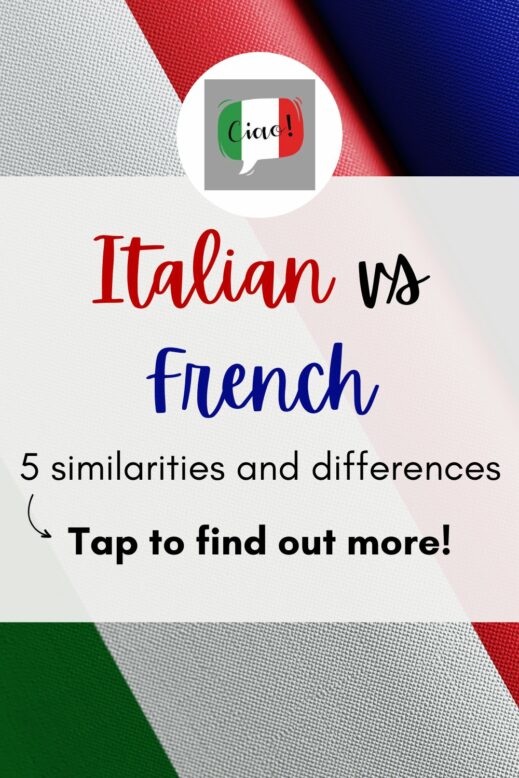If you are learning Italian and thinking of studying another language at the same time, one of the easiest you can choose is French. Although they share many similar characteristics due to their shared Latin heritage, there is enough that sets them apart to keep you entertained and challenged. Here are just a handful of the similarities and differences between these two Romance languages!

French vs Italian: 5 Similarities
1. Lexical similarity is 89%
According to the Ethnologue, Italian and French are the closest in terms of vocabulary of all the modern Romance languages, sharing an estimated 89% of words. This is because both can trace their origins back to Vulgar Latin. Quite often, the pronunciation is separated by little more than vocalised vowel at the end of the Italian term. For example:
French
Piscine (pool)
Appétit (appetite)
Italian
Piscina (pool)
Appetito (appetite)
2. Italian and French grammar is very similar
Growing up in Canada, I had to study French at school for nearly nine years, yet in all that time, I barely learned how to string a simple sentence together. It was only after I learned Italian that I suddenly found myself able to understand much of the French that had baffled me as a student! Why? Because the grammar is so similar!
Here are a few of the main similarities:
- they are both subject-verb-object (SVO) languages
- the word conjugation process is similar
- they often use the present perfect to express the simple past
- they make use of adverbial pronouns (en and y in French / ne and ci in Italian)
French
Je mange la banane.
(I eat the banana.)
Italian
Io mangio la banana.
(I eat the banana.)
3. Italian and French are considered “languages of love”
“Language of love” is a title that English speakers often bestow upon French and Italian. But what makes them two of the world’s most romantic languages? Well, it comes down to their euphonic quality, owing mostly to the equal distribution of vowels and consonants in words. (Germanic languages like English, by contrast, suffer from many harsh-sounding consonant clusters.)
What’s more, both languages build upon a long heritage of poetry, music, and art, which contributes to their romantic reputation.
French
Je t’aimerai pour toujours.
(I will love you forever.)
Italian
Ti amerò per sempre.
(I will love you forever.)
4. Italian and French both have a formal register
Language registers, such as they exist in Italian and French, don’t really exist in English. It’s true that we have formal vocabulary and phrases, but Italian and French can actually be divided into different independent registers. Whenever you address an older person, meet a stranger, or engage with others in the workplace, you should err on the side of caution and use formal language.
5. The alphabet is almost identical
The written alphabet of the two languages is more or less the same, albeit with different pronunciation rules. In Italian, the letters J, K, W, X and Y are not considered part of the proper alphabet, despite their presence in loanwords. French has the same set of written letters as the English alphabet.


French vs Italian: 5 Differences
1. Italian has regular spelling, French does not
Italian has what is called a “shallow” orthography, which means it has very regular spelling with an almost one-to-one correspondence between letters and sounds.
French, on the other hand, has a “deep” orthography in that the relationship between letters and sounds is less direct. One of the most problematic aspects for learners are the silent consonants in French – that is, consonants that are written but not pronounced. Often, the learner must simply memorise the unusual pronunciations of irregular words and hope for the best!
French
Baleineau
(Whale calf)
Italian
Balenottero
(Whale calf)
2. The polite pronouns ‘vous’ and ‘Lei’
We already mentioned that Italian and French have a formal register, but the formal subject pronouns aren’t the same.
In French, the pronoun vous is used to mean ‘you‘ formal or ‘you‘ plural, whereas in Italian, there is a separate formal pronoun Lei. Apart from the capital letter L, it shares the same spelling as the third-person feminine singular pronoun lei (she).
Informally, both languages use the pronoun tu.
French
Oui, tu es très gentil.
Yes, you are very kind.
(informal)
Oui, vous êtes très gentil.
Yes, you are very kind.
(formal)
Oui, vous êtes très gentils.
Yes, you are very kind.
(plural)
Italian
Sì, tu sei molto gentile.
Yes, you are very kind.
(informal)
Sì, Lei è molto gentile.
Yes, you are very kind.
(formal)
Sì, voi siete molto gentili.
Yes, you are very kind.
(plural)
3. Italian doesn’t require subject pronouns
French is similar to English in that the subject pronoun must always be clearly stated.
Italian, by contrast, is a “null-subject” language, which is just a fancy way of saying that the subject can usually be dropped unless it is required for emphasis, comparative purposes, and so on. This is because the person, number, and/or gender agreement is encoded in the verb conjugation.
English
I go to school.
They write an email.
French
Je vais à l’école.
Ils écrivent un e-mail.
Italian
(Io) vado a scuola.
(Loro) scrivono una e-mail.
4. Italian uses definite articles more often
A definite article is the equivalent of ‘the‘ in English. In French and Italian, the article changes according to the gender and number of the subject:
French
le = masculine, singular
la = feminine, singular
l’ = singular nouns that start with a vowel
les = plural (both genders)
Italian
il = masculine, singular
lo = masculine, singular (in front of vowels and certain consonant clusters)
la = feminine, singular
l’ = singular nouns that start with a vowel
i = masculine, plural
gli = masculine, plural (in front of vowels and certain consonant clusters)
le = feminine, plural
Unlike the French, however, Italians tend to use definite articles in front of possessive pronouns. For example:
English
my child
our car
French
mon enfant
ma voiture
Italian
il mio bambino
la mia auto
The only Italian possessive pronouns that don’t require a definite article are those that occur before the names of family members (e.g. mia zia instead of la mia zia for ‘my aunt‘).
5. French uses the split negative ‘ne’ and ‘pas’
If you want to make an Italian phrase negative, it’s really simple: all you have to do is place the word non (not) in front of the verb. For example:
Mangio la pasta. (I eat pasta.) > Non mangio la pasta. (I don’t eat pasta.)
Posso venire. (I can come.) > Non posso venire. (I cannot come.)
French, on the other hand, requires the use of the two negative words ‘ne‘ and ‘pas‘ which appear on either side of the verb.
Je mange les pâtes. (I eat pasta.) > Je ne mange pas les pâtes. (I don’t eat pasta.)
Je peux venir. (I can come.) > Je ne peux pas venir. (I cannot come.)

Heather Broster is a graduate with honours in linguistics from the University of Western Ontario. She is an aspiring polyglot, proficient in English and Italian, as well as Japanese, Welsh, and French to varying degrees of fluency. Originally from Toronto, Heather has resided in various countries, notably Italy for a period of six years. Her primary focus lies in the fields of language acquisition, education, and bilingual instruction.


